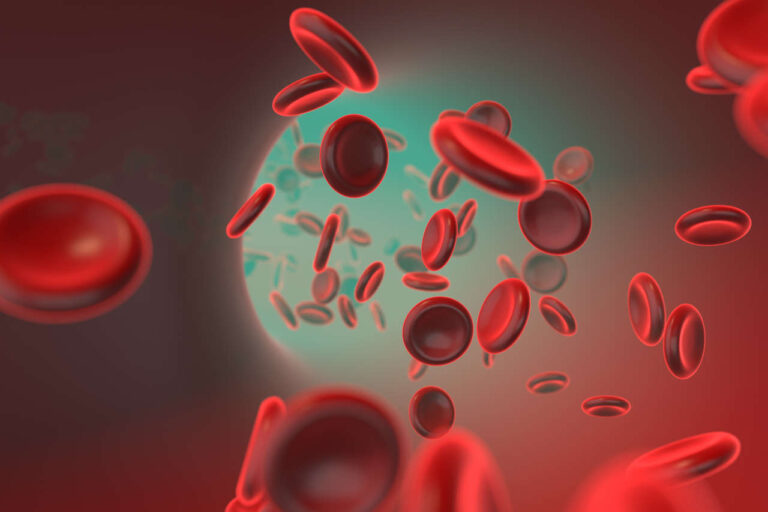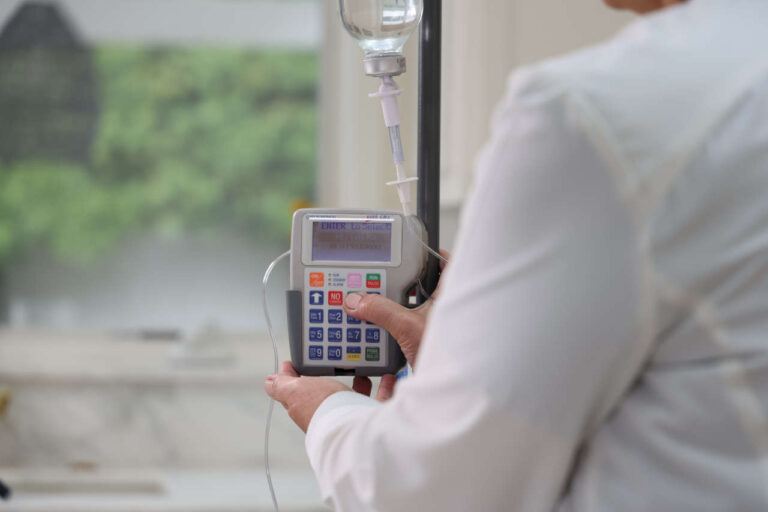
What Is Myasthenia Gravis?
Myasthenia gravis (MG) is a chronic autoimmune disorder in which the body’s own antibodies destroy the communication between nerves and muscles, consequently weakening skeletal muscles. This condition can affect any of the voluntary muscles of the body, but certain muscle groups are more commonly affected than others. These include muscles in the eye, face, throat, neck, and limbs [1].
Speak to a IVIG Specialist
MG affects about 20 per 100,000 people worldwide. In recent decades, prevalence has been increasing. This is likely the result of earlier diagnosis and better treatments leading to longer lifespans.
MG can develop at any age. For reasons that are unknown, it is most frequently diagnosed in women under age 40 and men over age 60. It is uncommon in children [2].
Symptoms of MG include [1]:
- Drooping eyelid(s)
- Diplopia (double vision)
- Impaired speaking
- Difficulty swallowing
- Chewing weakness
- Facial expression changes
- Impaired walking
- Difficulty holding head up
The cause of MG is unknown and there is no cure, but early detection and prompt medical management can help control symptoms and lead to longer, more functional lives [3].
The treatment goals are to increase muscle function and prevent swallowing and breathing problems. Treatment may include [3]:
- Medications – short-term treatment that aids in suppressing, reducing, and strengthening the body’s immune system. These include anticholinesterase medications, steroids, or other medications that suppress the immune system’s response (immunosuppressives).
- Thymectomy – surgical removal of the thymus gland. A thymectomy may or may not improve symptoms, and the role of the thymus gland in MG is still not fully understood. However, in more than 70% of people who do not have thymus cancer, there is a reduction of symptoms.
- Plasmapheresis (plasma exchange therapy) – a procedure that removes abnormal antibodies from the blood. The blood is then replaced with normal antibodies from donated blood. This method is short-term but is useful as a rescue treatment for patients in crises.
- Intravenous Immunoglobulin (IVIG) – a product pooled from donated blood that alters the immune system and neutralizes damaging antibodies.
Can IVIG help?
Free IVIG Treatment Info | Difficulty In Diagnosing?What Is IVIG?
IVIG is a blood product that combines immunoglobulins donated by various people to treat a variety of infectious and inflammatory diseases. Since 1984, it has been utilized in the treatment of numerous autoimmune conditions including MG, and studies have shown that IVIG is an effective treatment for a lot of patients who have MG.
How It Works
The exact mechanism of how IVIG works in treating MG is not entirely understood, but MG is primarily triggered by autoantibodies which target acetylcholine receptors in the bloodstream. IVIG alters the immune system, destroying and neutralizing these autoantibodies, thus stopping the production of new autoantibodies. This ultimately minimizes the occurrences or relapses of MG symptoms.
How IVIG Is Used To Treat Myasthenia Gravis
Without proper medical attention, MG can be fatal. IVIG is administered when there is a need for a prompt response, often while waiting for other medications to take effect. It can also be used as a “rescue” treatment if there is an acute relapse of symptoms [4]. When other therapies are not effective in managing symptoms and chronic relapses of symptoms occur, IVIG may be prescribed as maintenance therapy. Given regularly, IVIG maintains proper immune function and helps prevent the development of new antibodies that would otherwise interfere with muscular contraction. However, the frequency of the treatment varies depending on the individual. The following factors are taken into consideration:
- Age
- Medical history and overall health
- Severity of MG
- Patient preference
- Allergies
Your doctor will personalize a treatment plan to best suit your condition and needs.
Get IVIG Copay Assistance
IVIG Financial AssistanceWhy Is IVIG So Popular?
Since MG can cause swallowing problems, IVIG is a convenient treatment for patients as it is given intravenously. IVIG is administered directly into the bloodstream, which offers quick relief and is particularly useful in treating an MG exacerbation.
Also, IVIG has a very low risk of infection. Donors are thoroughly screened for certain infections and viruses and donated blood plasma further undergoes extensive processing for purification and inactivation/removal of certain viruses.
How Is IVIG Administered?
IVIG is given intravenously using an ambulatory infusion pump. This can be done at a doctor’s office or in the comfort of a patient’s home. A nurse will administer the medication and monitor vitals throughout the infusion, which can be 3 – 5 hours long, depending on the dose. Pre-medications, such as Tylenol and Benadryl, are usually given before each infusion to help with side effects and any allergic reaction.
How Long Does IVIG Take To Work in Myasthenia Gravis?
Response varies from patient to patient. It may take a week or two before improvement is seen. The duration of improvement also varies but can last a few weeks to a few months.
How Often Can You Get IVIG Treatment for Myasthenia Gravis?
The frequency of IVIG for MG depends on the urgency of treatment. It can be used either as a rescue therapy, such as during a myasthenic crisis or MG exacerbation, or as maintenance treatment. As a rescue therapy, the dose is divided over 2 to 5 consecutive days. When used to manage MG symptoms, patients will receive a routine maintenance dose every 4 to 6 weeks. Depending on your response and symptoms, your doctor will make adjustments to your therapy.
Get IVIG Prior Authorization
Side Effects
Side effects include:
- Headache
- Fever
- Flu-like muscle or joint pain
- Stomachache
- Fatigue
- Chills
- Flushing
- Nausea
- Rash
Most patients tolerate IVIG well, but the above side effects can occur. Premedications are often prescribed to relieve and prevent side effects. Slowing down the infusion rate may also help if side effects are experienced during infusion. A nurse will monitor you throughout the infusion and will slow down or stop the infusion as needed.
Adverse reactions such as renal dysfunction (kidney impairment), thrombotic events (blood clots), and aseptic meningitis may occur after infusion. Inform your doctor immediately if you start experiencing fluid retention (i.e., swelling in legs or ankles), shortness of breath, irregular heartbeat, pain or swelling in just one leg or arm, chest pain, fever, or a stiff neck.
Drug Interactions
IVIG does not usually interfere with other medications. However, passive transfer of antibodies from the product itself may temporarily impair the immune response to live vaccines and alter its effectiveness. Therefore, IVIG administration and vaccine administration should be separated.
It is important that you let your doctor know all medications you are taking and any recent vaccinations before starting IVIG.
Pregnancy and Breastfeeding
IVIG is safe to use during pregnancy and is compatible with breastfeeding.
Cost of IVIG for Myasthenia Gravis
IVIG can be costly and depends on numerous factors, which include:
- Diagnosis
- Weight
- The number of doses needed
- Length of treatment
- Brand
For these reasons, the price of IVIG varies from one person to another. Typically, the cost ranges from $100 to $350 per gram. Insurance coverage will also determine how much you will need to pay to receive treatment.
Copay Assistance
To offset costs, there is funding available from various foundations and copay assistance programs. Complete this HIPAA-compliant form to get assistance in finding funding. If you qualify, costs may be greatly reduced. Patients can check their copay eligibility through any of three ways:
- Reach out to your pharmacy provider.
- Research non-profit organizations that can help with financial assistance.
- Reach out to the IVIG brand manufacturer.
Get IVIG Copay Assistance
Speak to a SpecialistFinal Thoughts
IVIG is recommended for patients with MG. Although it may not make MG disappear, it is effective in controlling symptoms and improving quality of life. Speak to your doctor or contact us today to see how we can assist.
REFERENCES:
- Myasthenia Gravis
https://www.mayoclinic.org/diseases-conditions/myasthenia-gravis/symptoms-causes/syc-20352036.
Accessed on May 2, 2022. - Myasthenia Gravis
https://medlineplus.gov/genetics/condition/myasthenia-gravis/.
Accessed on May 3, 2022. - Myasthenia Gravis
https://www.hopkinsmedicine.org/health/conditions-and-diseases/myasthenia-gravis.
Accessed on May 4, 2022. - Intravenous Immunoglobulin
https://www.myaware.org/ivig-information-sheet.
Accessed on May 5, 2022. - MG Brochures – Intravenous Immunoglobulin
https://myasthenia.org/MG-Education/Learn-More-About-MG-Treatments/MG-Brochures/intravenous-immunoglobulin-ivig. Accessed on May 12, 2022.













